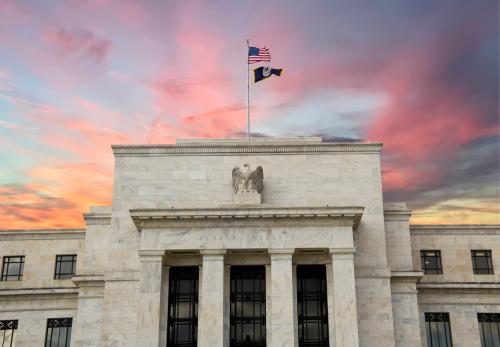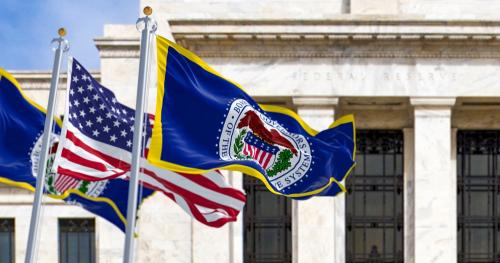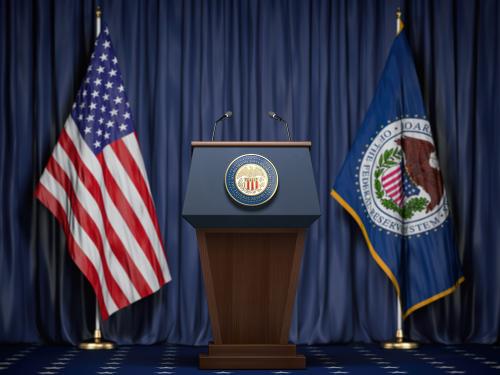Don Kohn holds the Robert V. Roosa Chair in International Economics and is a senior fellow in the Hutchins Center on Fiscal & Monetary Policy in the Economic Studies program at the Brookings Institution. Kohn is a 40-year veteran of the Federal Reserve system, serving first as a staff economist, and from 2002 to 2010 he was a member and then vice chair of the Board of Governors. Since the 1980s, he has been a frequent participant in the Kansas City Fed’s high-profile Jackson Hole conference. David Wessel, director of the Hutchins Center, talked to him about this year’s conference.
David Wessel: How did the mood of Jackson Hole this year compare to last year?
Don Kohn: It was much more relaxed among the central bankers. Last year, in August 2022, inflation was extremely high. The attendees, including the central bank attendees, wondered what they had to do with monetary policy to begin to get some control over this inflation and move it back towards their 2% targets. Interest rates were on the way up. The Bank of England had started tightening the previous December. The European Central Bank had started in July. The Fed had started tightening policy in March 2022. It had tightened by an unusually large 75 basis points in early July, but it was unclear what the effect of this tightening would be, how far it would need to go, and whether that would be successful bringing inflation down.
At this year’s Jackson Hole, the consensus was that the major central banks had tightened enough to make policy restrictive, restraining growth with the promise of bringing inflation down. In fact, recent data had suggested, at least in the U.S. and, to a lesser extent, in the eurozone, that inflation was coming down, and pressures in labor markets were moderating. So they felt like they were in the neighborhood of where they needed to be, at least in the U.S. The ECB wasn’t clear whether they were there yet. The message was: Policy is restrictive. We don’t know whether it’s restrictive enough. We are not going to let up too soon on this tight policy.
There are encouraging signs, but there are also signs pointing the other direction. Fed Chair Jay Powell, for example, talked about the re-acceleration in the real estate market and the strength of aggregate demand recently that might prevent the further rebalancing of labor and product markets. There was cautious optimism, but a sense that the job might not be done yet. They would need to see.
Powell and ECB President Christine Lagarde absolutely ruled out moving away from the 2% inflation target. There was no ambiguity about that. There was no discussion. And neither of them mentioned the possibility of lowering interest rates.
David Wessel: So if the near-term picture is looking somewhat more comforting, there must have been more focus on the long-term structural issues that the world economy faces. Did you find that?
Don Kohn: Exactly. And that was the theme of the conference that the Kansas City Fed had set out, looking at changes in longer term trends, the structure of the economy, globalization, productivity, etc., and what they might imply for economic performance and therefore for the role and the job of the central banks.
David Wessel: So do central bankers think their job is getting harder because the world is changing in ways we don’t understand?
Don Kohn: Yes—I think different, leaning towards harder. A number of general trends were discussed. One was productivity, and there was one very striking chart (slide 3) that Chad Jones showed of overall economic growth in the U.S. dating back to the 1800s, and there was a 2% trend line. But another chart showed that growth in total factor productivity has slowed over the past decade. Jones noted that the generation of ideas to support productivity growth was becoming harder. As he put it, “We have to invest ever-rising resources in R&D just to maintain a constant rate of economic growth.”
He cited some hopeful signs here—for example, bringing India and China into the global trading system with their ability to generate new ideas and vast amounts of increasingly educated people. There’s the reallocation of resources even in the United States, reducing discrimination against women and people of color, bringing their talents more into the labor force, things like that. And then there’s the potential that AI will boost productivity. But there was no consensus on how much productivity AI would generate or when. Alan Greenspan often cited Paul David, the Stanford economic historian, who showed that it took a long time in the early 20th century for electricity to lead to an increase in economy-wide productivity—and some thought AI would boost productivity growth, but it would follow this delayed timeline.
On the other hand, educational attainment in the U.S. has leveled out, and there has been a correlation between increasing education attainment and increasing new ideas, patents, and things like that. And this sense that you needed more and more resources to produce a patent to have a new idea. Chad Jones was agnostic on where we were going, but there are both some encouraging and some discouraging trends on the productivity side.
There was another Jackson Hole paper in which the authors, Yueran Ma and Kaspar Zimmermann, had what seemed like a very high estimate of the adverse effects of higher interest rates on investment in research and development and innovation. And they implied, although they tended to back off a little bit in the conclusion, that somehow monetary policy ought to take account of its effects on innovation.
My one intervention from the floor was to say that I thought the best contribution monetary policy could make to innovation was to set a stable economic background for innovation. Stability of the price level, stability of the business cycle. And that I had been reflecting on the Great Moderation of the 1980s and 1990s and hypothesized that had facilitated the surge in productivity in the second half of the 1990s. My conclusion was: Central banks have enough to do trying to stabilize prices and the business cycle, and succeeding at that is the best contribution they can make to promoting innovation.
David Wessel: Apart from all the discussion of what will happen to interest rates next and all that, were there other things that you thought were noteworthy, either in conversation or on the formal program?
Don Kohn: There was a lot of discussion of globalization. The reshoring, the onshoring, the friendshoring, changing global supply chains to emphasize resilience, and breaking away from dependence on China, the geopolitical effects on supply chains and the efficiency and the prices that came out of that, all seemed to be moving in a direction of higher costs and less efficiency. And there was concern for sure. The paper by Laura Alfaro and Davin Chor showed that there had been quite a bit of re-channeling of supply chains away from China. U.S. imports from China are way down, but we are importing enough more from Vietnam and Mexico to make up for the decline from China—a rechanneling. So, it is sort of encouraging that the openness of the U.S. economy hasn’t declined, but the authors of this paper also showed that a lot of the factories producing the stuff that was now flowing from Vietnam and Mexico were owned by Chinese. The Chinese firms themselves, in order to get around potential restrictions, were expanding in Vietnam and Mexico, so that it wasn’t clear just how much de-risking had occurred. And they also showed that the changing and flows did raise costs, did raise prices. There was perhaps not agreement on how much, but there was no question that it made things more expensive to do this. Some of this redirection might’ve happened anyhow because Chinese wages are rising, etc. But it had gotten an extra push from the geopolitical risk.
I thought a very interesting finding was that the more open economies are, the more diversified trade is, the more resilient economies are. As new supply chains were added and diversified, made more efficient over the 1990s and early 2000s, prices came down, but the exposure of economies to shocks abroad went up. I wondered which way this was going to go. To one extent, the more open you are, the more exposed you are to shocks from the outside world. But the more open you are, the more that shocks internally can be absorbed by trade relations with other countries. A couple of charts showed that business cycle stability was positively related to the openness of the economy. So therefore, there was some concern that as economies became less open, the more reshoring and friendshoring that went on, the less resilient they would be. And, I think President Lagarde made this point in her lunch speech, and therefore the more burden there would be on monetary policy makers to offset more kinds of shocks.
David Wessel: There wasn’t anybody from the Chinese central bank there?
Don Kohn: No.
David Wessel: Whenever Christine Lagarde speaks, she always puts climate change pretty high on her things to worry about. And that’s quite a contrast from what you hear from the Federal Reserve. Why is that, and is the Fed doing the right thing?
Don Kohn: It reflects, to some extent, the political environment in the two places. In Europe, particularly now, given their exposure to reliance on Russian gas, etc., they’re embracing the need for renewables. There’s more consensus in Europe that climate change is a problem, that human activity has been an important contributor to climate change, and that we need to do something about it, whereas we know in the U.S., that’s not the case. Here there’s quite a bit of partisan wrangling over whether it exists, and if it exists, what the effect of human activity is, and then how to mitigate climate change without imposing too much cost on people. I think the Fed is, and in my view appropriately, given this political environment, being very careful to focus its attention on the climate change risk to the financial system, rather than to the economic system or climate change per se, and to be less forward-looking in that regard. I was sitting next to a deputy governor from the Banque de France in one session when there was a discussion of threats to stability. And at the end of the session, she had her hand up, she didn’t get called on, but she said, “I was going to ask: Where’s climate change? So you’re not discussing climate change at all.” She was quite struck by the absence of that discussion with respect to the U.S. situation.
David Wessel: There seems to be rising populism in a number of countries, not only ours, which I think threatens the independence of the Fed and other central banks, but also sort of the willingness of the society to let technocrats make big decisions. Was that at all in the air at Jackson Hole, or is that just not something that came up?
Don Kohn: No, I don’t remember it coming up, certainly in the sessions. I didn’t hear discussion of that, but I think that leads me into reflecting on one topic that we haven’t covered, which is the fiscal deficit. A paper by Barry Eichengreen and Serkan Arslanalp was very discouraging with respect to the trajectory of the debt to GDP ratio in the U.S. and in many other countries as well. We’re running a primary deficit in the U.S. – that’s spending on everything besides debt service in excess of receipts – and the political system seems unwilling or unable to deal with this primary deficit, which is very large, especially considering we are at full employment with an inflation problem. And it’s going to get larger with the demographics of the population putting more pressure on Social Security, Medicare, and probably Medicaid as well. So that was discouraging.
You can run a primary deficit, a small primary deficit, if the growth of the economy (g) is greater than the interest rate (r) that the government is paying on its obligations. In the U.S., r has been below g partly because monetary policy has been trying to stimulate the economy and partly because the U.S. is a safe haven for global capital flows. So that bids down interest rates on the U.S. government debt in particular. Going back to productivity in discussion, productivity, if anything, had been lagging below long-term trends. So g didn’t seem very promising. And at the same time, there are reasons to think that r might be higher if for no other reason than these government deficits are so large, and r would be higher to crowd out private spending. Government spending is likely to increase to make the electric grid and the whole economy less reliant on carbon-intensive means of production and driving. In addition, geopolitical circumstances will raise spending on defense, and monetary policy was no longer trying to raise growth and inflation. So there were a number of reasons to think that interest rates might be higher. It isn’t clear if they will be higher than the growth rate, but at least the gap between them (r minus g) would be smaller.
The other point that Eichengreen and co-author made was that, in recovering from the huge debt load of World War II, there was quite a bit of what economists call financial repression—that is, control over the rise in interest rates and requirements that people put money in government bonds. For example, in the banking system before the 1980s, there was Regulation Q, which meant there was a limit on the level of interest rates banks and thrifts could pay on deposits. And the view was that in current circumstances, with non-bank intermediaries growing in importance and many fewer restrictions on global capital flows – which was part of the financial repression of the 1950s and 60s – that financial repression could not be counted on to solve the problem of r being high relative to g or rising relative to g. So it was a very gloomy time, in some sense. One lesson that was drawn for monetary policy was, there would be less likelihood that fiscal policy could be used and would be used forcefully to counter a future disturbance in the economy because the debt-to-income ratio was already very high and destined to go much higher. That would put more burden on monetary policy.
An interesting intervention from the floor came from Phill Swagel, who was recently reappointed the head of the CBO. He asked: “What do you think might force the hands of the politicians?” He offered a couple of alternatives. One was the expiration in 2025 of the individual tax cuts in the 2017 Trump tax cut package. And there’ll have to be some negotiation about what to do with that. And then when some of these trust funds begin to run out of money – Social Security, Medicare in the early 2030s – that will force, he felt, or some people felt, the reexamination of entitlements. But those are some time away. Other people talked about when the debt ceiling comes up again, and things like that. But it wasn’t clear that there would be an event that forced the politicians to sit down and really horse trade and compromise on taxes and spending to get control of this path.
David Wessel: It’s always nice to go to Jackson Hole. It’s a beautiful place. And it’s cool to be included in the annual Jackson Hole conference. What value do you think conferences like this have either to policymakers or to the public good in general?
Don Kohn: There are two ways it’s beneficial. One is that some of the papers given at Jackson Hole over the years have been very influential. They tend to be less technical than the papers in the economic journals. Occasionally, you see an equation, there are Greek letters every once in a while, but not a lot. And when they’re up there, they’re translated into English. In fact, there’s no PowerPoint. People hand out their PowerPoints, which I think often makes for a more informal type of presentation. But they’re pretty sophisticated in terms of the ideas. So I think there have been papers over the years that have proven very valuable to economists and policymakers thinking about the structure and the way economies are evolving and the way monetary policy, and sometimes fiscal policy, has to be made under these circumstances. The papers are well aimed to be cutting edge on ideas, but accessible to most policymakers, and journalists for that matter.
I think the other thing is the informal conversations. On hiking trails, I guess on the float trips – I haven’t been on one of those in many years – at the bar, either after the evening’s activities or between the afternoon and evening. People make connections. It’s more informal than your typical conference. And people are more relaxed, I think, in this environment, and willing to trade ideas and be open about the issues they’re facing. I found that to be the case when I was at the Fed, particularly among central bankers. Yes, you go to Basel and you see these same people, but you see them in a meeting environment where they’re clearly speaking for their institution. When you’re half out of breath walking up Paintbrush Canyon or Cascade Canyon, these inhibitions tend to fall away. And you get a little bit of a more open discussion with your colleagues from other central banks, and between the economists and the central bankers.
I did talk to somebody about live streaming the conference. because I know the ECB livestreams its Sintra conference. This person was not in favor. They felt that there would be more posturing. I said, but the reporters are there reporting everything. We do have at Jackson Hole people who tend to make speeches when they stand up to be called on to “ask your question.” We see this at Brookings all the time. But this person felt it would be far worse if that person asking the question knew a camera was on them. and it would be broadcast to the rest of the world. And so they were not in favor of livestreaming. They thought the lack of livestreaming added to the informality in the discussion. There were good discussions after the papers. And the two moderators, Betsey Stevenson one day, and Christie Romer the second day, did a really good job of moving things along. They cut a couple of people off in mid speech.
David Wessel: I probably have the reporter’s bias here, so yes, that’s a risk. I agree with that. But when I went to Jackson Hole, there was plenty of posturing without cameras there. And I think there’s also a cost that has grown over time – the criticism of the secrecy of central bankers. So I know that the Federal Reserve Board has insisted that Powell’s speech be livestreamed, and it is. I’m not sure why Christine Lagarde’s speech couldn’t have been live streamed.
Don Kohn: Of course. No. But she took questions. He does not.
David Wessel: Yes, but on the questions to Lagarde, the reporters are there for that. So it’s not like the questions are off the record. You know that the world has changed. Yes, there’s a risk of posturing if the conference is livestreamed. but there’s also a cost to keeping it secret. They’ve changed the attendance over the years. There are fewer people from Wall Street, aren’t there?
Don Kohn: There are much fewer people from the financial sector. Julia Coronado was there. Diane Swonk was there, and both of them actively participated. And I think that’s good. But it wasn’t like in my memory from the ’80s, when Henry Kaufman and Jan Hatzius, and maybe Bill Dudley when he was at Goldman, were there. I think those folks do bring a perspective that’s helpful to hear.
-
Acknowledgements and disclosures
The Brookings Institution is financed through the support of a diverse array of foundations, corporations, governments, individuals, as well as an endowment. A list of donors can be found in our annual reports published online here. The findings, interpretations, and conclusions in this report are solely those of its author(s) and are not influenced by any donation.
The Brookings Institution is committed to quality, independence, and impact.
We are supported by a diverse array of funders. In line with our values and policies, each Brookings publication represents the sole views of its author(s).





Commentary
Don Kohn’s reflections on Jackson Hole 2023
September 5, 2023